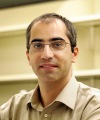Clinical Research Unit Medical Director
Clinical Research Unit, North Carolina
Stavros Garantziotis, M.D., is the Medical Director of the NIEHS Clinical Research Unit (CRU) and head of the Matrix Biology Group in the Laboratory of Respiratory Biology. Dr. Garantziotis answers several questions regarding the CRU’s mission and its importance for NIEHS.
-

-
Stavros Garantziotis, M.D. (http://www.niehs.nih.gov/research/atniehs/labs/lrb/matrixbio/index.cfm)
Acting Director, Clinical Research Program
CRU Medical Director -
Tel (919) 541-9859
Fax (919) 541-4133
garantziotis@niehs.nih.govCurriculum Vitae (47KB) -
P.O. Box 12233
Mail Drop E1-03
Research Triangle Park, North Carolina 27709
Delivery Instructions
| Question for Garantziotis | Transcript of Answer |
|---|---|
Why does NIEHS need a Clinical Research Unit (CRU)? Running Time: 1:28 | The mission of the NIEHS is to promote human health by uncovering the ways that the environment influences human disease and human health, and indeed the NIEHS had a long and successful track record of basic research, that means test tube and animal model research, and epidemiological research in human health. However, we are looking for new and better ways of translating the findings of our basic and epidemiological research in human health. The Clinical Research Unit is aspiring to be the core facility addressing clinical research. Clinical research has been a part of the NIH portfolio for quite some time. As an example the |
What is the mission of the Clinical Research Program at NIEHS, and how do you decide what to study at the CRU? Running Time: 0:24 | In general, I would describe the core mission of the clinical research program at NIEHS as translating the basic research findings of our investigators into human health gains. There are three main factors that we are always considering when we are thinking about what diseases to study. The first is what is the health impact of what we’re studying? In other words, how many people are going to be effected by the results of these studies, and how important are those findings to the health of these people? The second factor is can we perform this research safely? The third factor is how much evidence is there for what we’re trying to study? In other words, what is our level of confidence in what we know, so that we have a fairly good sense that what we’re trying to study then in human subjects will indeed be important and will indeed have an impact on their health. It is never a fishing expedition, a shot in the dark type of research. We always try to base our research on very solid basic research findings, in the animal or test tube, before we move on to test this question or idea in human subjects. |
Specifically, what diseases will be studied at the CRU? Running Time: 0:59 | There are many investigators that study different aspects of human disease, such as cancer, metabolic diseases like diabetes or high cholesterol, neurological diseases like Parkinson’s Disease or Alzheimer’s or inflammation just to mention a few. So, these are all subjects of investigation that we will be addressing in clinical research. For example we are very interested in how genes and the environment affect asthma. We know, for example, that smoking or diet may have an effect in asthma. Also, environmental exposures such as ozone can affect an asthmatic person’s disease or propensity to develop exacerbations in the disease. |
Will CRU investigators experiment on human subjects? Running Time: 1:22 | "Clinical research" sometimes sounds scarier than it actually is. The great thing about medical advances is that meanwhile we have the ability to test several disease processes in humans without really having to do invasive tests. So, clinical research can be as simple as answering a questionnaire as to what diseases you have or what symptoms you may be experiencing and then giving a blood sample or urine sample or a sample of phlegm, so that we can test, for example, for drugs or pesticide levels or genes in your blood. As in another example, we can isolate cells from the blood and test them in the test tube, how those cells would respond to different chemicals or antibiotics or infectious agents. That will give us clues as to the effect of the genes or drugs that we’re studying in human health, without necessarily having to perform invasive tests in the actual human being. We’re not going to be experimenting on people. |
What do you want the public to know about the CRU? Running Time: 1:10 | There are three points I’d like to make about clinical research at the Clinical Research Unit at the NIEHS. The first is that it is a very important translational link between what we know from basic research. In other words, does our knowledge from animals and cell cultures apply into actual human beings? The second point is that the knowledge that we will gain from clinical research will help inform public policy by regulatory officials and would hopefully help the American people make more informed decisions about individual lifestyle. Thirdly, clinical research at the Institute will have to be the safest possible so we can hopefully have the combination of both very high quality research, with high-impact findings, but also very safe research that will not put any of the participants in research at risk. |
Video Help
Need help? Visit the video test page or Email video support
Download Media Players:  QuickTime
QuickTime
Terms of Use
These video clips and the three images on this page are in the public domain and copyright free. Anyone is freely able to use these files. These materials were created by the Office of Communications and Public Liaison of the National Institute of Environmental Health Sciences. As a courtesy, it is requested that an appropriate acknowledgement be given: "Courtesy: National Institute of Environmental Health Sciences."

